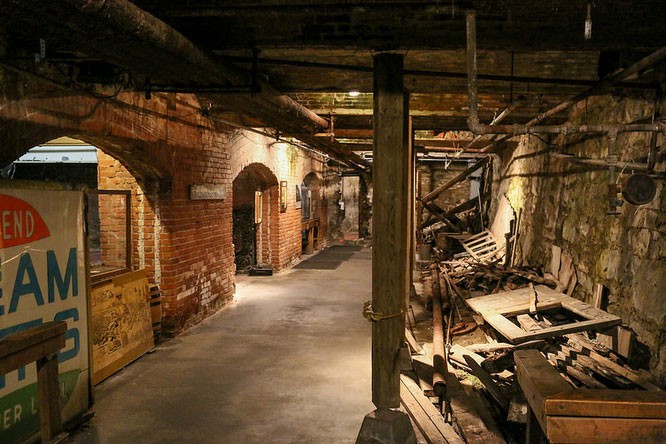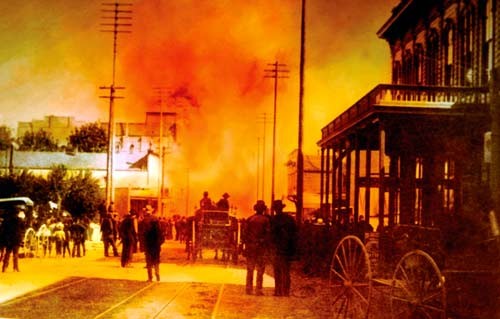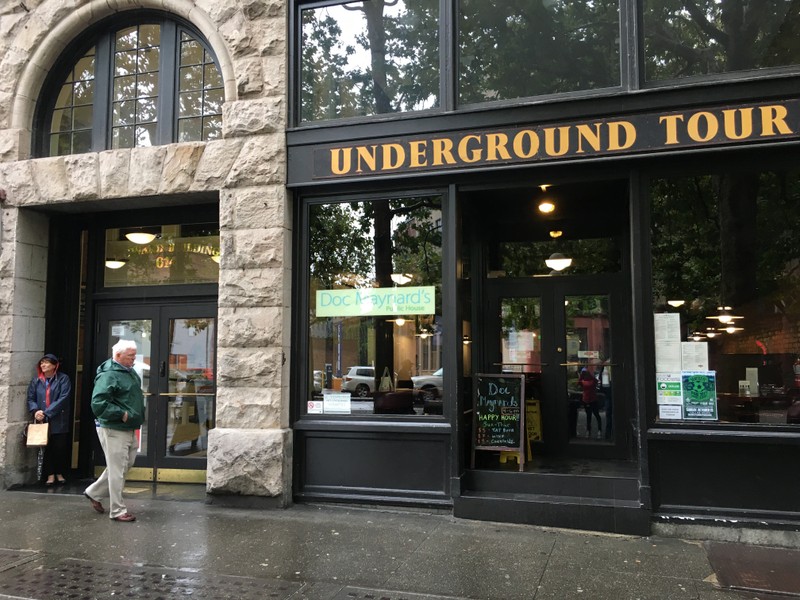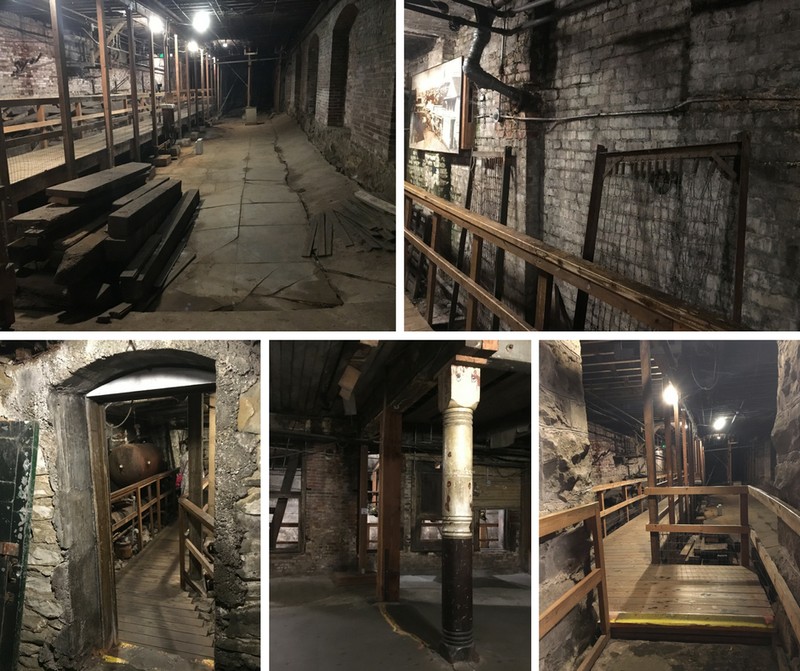Bill Speidel's Underground Tour
Introduction
Text-to-speech Audio
Former newspaper editor Bill Speidel created this tour of the historic tunnels beneath the streets of Pioneer Square in the 1960s, largely in hopes of generating interest in historic preservation for the neighborhood. The first underground tour of Seattle occurred in May 1965 and was an immediate success, with approximately 500 people going on tours of the still-intact tunnels beneath Seattle’s brick sidewalks. The creation of the Underground Tour both simultaneously exposed locals to the intact city beneath their feet, and restored the city’s birthplace, Pioneer Square, which is where the tour is centered. Pioneer Square was finally made into a Historic District in May 1970, thanks in part to these tours. The tours continue today with trained guides taking visitors on a 75-minute guided tour of the tunnels and streets of the Pioneer Square neighborhood.
Images
Tunnel Under Seattle

Old Photograph of the Great Seattle Fire

Underground Tour Entrance

Collage of Several of the Tunnels Traveled on the Tour

Backstory and Context
Text-to-speech Audio
Before a tour of the tunnels underneath the city, the Underground Tour first informs people of how these tunnels came to be, as well as how that correlates with the original establishment of the city. Seattle was founded in 1851 by a group of businessmen that included Arthur Denny. These men first landed on the eastern shores of Puget Sound, decided it was unsuitable for their establishment, and moved further east, more inland, which is where downtown Seattle is located today.[1] The town was founded on mostly soggy tide flats whose streets flooded easily due to the fact that it was originally built during low tide. Because of this, plumbing was an issue, and toilets often spewed water and sewers worked backwards. Besides the plumbing, however, the spots in the city that weren’t soggy became so because of the rain. Top that off with constant wagons and horses constantly plowing into the mud; Seattle was an utter mess. The goal of living in these horrid conditions was to be close enough to Puget Sound and Elliott Bay was to ensure that the city was a “freeway for maritime commerce.”[2] This goal was envisioned by none other than Denny himself, as well as his archrival, Dr. David Swinson Maynard. The tour highlights the latter because he owned much more Seattle land than Denny did, yet is often overlooked when discussing the history of the town. Because the conditions of the town were so unfortunate, entrepreneurs started putting houses on stilts and leveled the streets in order to lessen some of the mud that riddled the city. To level the land, they used anything they could find: timber, sawdust, dirt from nearby hills, and even everyday trash. So in addition to Seattle’s streets being an utter mess, there was also rotting garbage and sewage underneath the city as well.
The one saving grace for the city of Seattle was oddly enough a fire. The Great Seattle Fire of 1889 killed over a million rats, destroyed 25 blocks of buildings, homes, and businesses, and caused 5,000 men to lose their jobs. Over $20 million was lost to this tremendous fire that, oddly enough, started with a glue incident in a woodworking shop.[3] By the time the fire department got to the scene, there was too much smoke to determine where the fire was coming from. In addition to that, the fire fighters at that time were all volunteers. Most of the attempts to stop the fire failed, and it was allowed to spread to so much of the city. Though the devastation left in the wake of the fire was great, many people of Seattle actually saw this as a great opportunity; they could get a fresh start. They could finally correct all the past errors that went into building Seattle, start creating stronger infrastructure, and just make smarter decisions about the city. The first of these decisions was to form a better fire department.
One of the most important decisions in regards to the city that still affects it to this day is the decision to raise the streets. Streets were raised up to 22 feet, helping to level the hilly city.[4] Though the streets were raised, there were still gaps in between the streets, where houses were built. So essentially, instead of Seattle being a flat muddy pancake like before the fire, it was then almost like a giant waffle. "Building owners [...] rebuilt on the same old, low, muddy ground where they had been before, unmindful of the fact that their first floor display windows and lobbies would soon become basements […] Eventually, sidewalks bridged the gap between the new streets and the second story of buildings, leaving hollow tunnels (as high as 35 feet in some places) between the old and new sidewalks, and creating the passageways of today's Underground."[5] Though the decision to raise the streets helped correct some of the original mistakes of the foundation of Seattle, it also just served to create more problems, and people with a little too much to drink could easily plummet over 20 feet if they didn’t look where they were going and stepped off a sidewalk.
In 1897, adventurers passed through Seattle on the way to Alaska for the Yukon Gold Rush. Pioneer Square's underground tunnels were largely forgotten as the business district moved uptown. It was only thanks to Bill Speidel that it was restored and became the experience that it is today. Speidel, the man who created the Underground Tour, is remembered most for his wit and his “irreverent sense of humor.”[6] The man lived until 76, but not before spearheading the campaign to preserve Pioneer Square by creating the Underground Tour. According to his tour website, “In 1946, he quit newspapering and opened his own public relations business, eventually located in Pioneer Square, the city’s birthplace. Speidel became an ardent preservationist as the bandwagon gained traction in the 1950s and 1960s. He is one of a group of visionaries who saved Pioneer Square by mounting a citizen campaign to convince the city to designate downtown’s oldest neighborhood an historic district, thus sparing from the wrecking ball the largest collection of Victorian-Romanesque buildings in the United States.”[7]
Though Seattle has plenty of museums and books on its history, the Underground Tour offers a hands-on authentic approach. With wild tales of Seattle's upbringing, witty comebacks, and incredible sites, this tour is one visitors can’t pass up. The tunnels underneath Seattle depict architecture from years past, and even parts of buildings that are still intact. One room is a courthouse with a picture of the original building before it sank, another has a still intact toilet in it. In some places, there are even glass panes (manganese glass, a lovely lavender color) where people can see the everyday people of Seattle walk overhead. With amazing architecture, cool tunnels, intriguing history, and witty guides, the Underground Tour is truly an experience visitors won’t want to miss in Seattle, Washington.
Sources
[1] “Bill Speidel's Underground Tour.” Underground Tour - A Tour of Seattle's Under Ground. Accessed February 21, 2020. http://www.undergroundtour.com/about/index.html.
[2] “History of Seattle, Washington.” History of Seattle, Washington. Accessed February 21, 2020. https://u-s-history.com/pages/h2080.html.
[3] “Bill Speidel's Underground Tour.”
[4] “The Great Seattle Fire.” Washington. Accessed February 21, 2020. https://content.lib.washington.edu/extras/seattle-fire.html.
[5] “The Great Seattle Fire.”
[6] “Bill Speidel's Underground Tour.”
[7] “Bill Speidel's Underground Tour.”
[8] “Bill Speidel's Underground Tour.”
Additional Readings:
“The Great Seattle Fire of 1889.” The Great Seattle Fire of 1889 - CityArchives. Accessed February 21, 2020. https://www.seattle.gov/cityarchives/exhibits-and-education/digital-document-libraries/the-great-seattle-fire-of-1889.
“Bill Speidel.” prabook.com. Accessed February 21, 2020. https://prabook.com/web/bill.speidel/2469371.
“Underground Tour Highlights Seattle's Strange History: CityPASS Scrapbook.” CityPASS. Accessed April 23, 2020. https://www.citypass.com/articles/seattle/underground-tour-highlights-seattles-strange-history.
“Bill Speidel's Underground Tour.” Underground Tour - A Tour of Seattle's Under Ground. Accessed April 23, 2020. http://www.undergroundtour.com/about/index.html.
Nomadicniko. “Bill Speidel's Underground Tour (Seattle, Washington).” Nomadic Niko, January 2, 2020. https://nomadicniko.com/2017/10/18/underground-tour/.
Jen. “Exploring Seattle's Underground in Pioneer Square: Hidden History in Seattle.” Jen There Done That, January 19, 2020. https://jentheredonethat.com/seattle-pioneer-square/.
